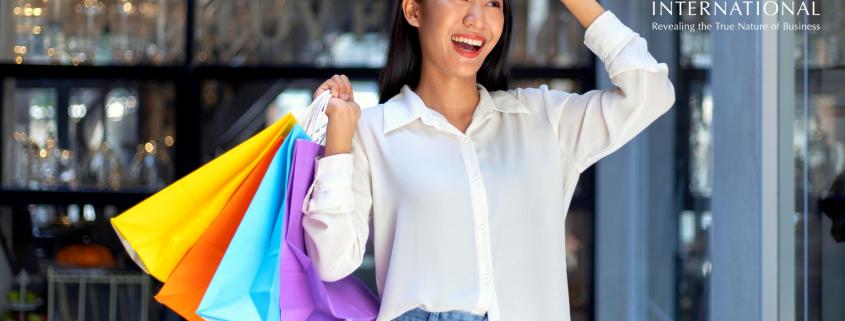How ‘Super Store’ Designs Enhance Customer Experiences
The bigger the store, the better the performance? How the latest ‘Super Store’ strategy helps fashion brands transform into new retail, and combat aging brick-and-mortar stereotypes.
Joanna Wang stared at the appointment date that popped up on the phone page and found that the October schedule was almost gone. At the end of September, when she heard that the flagship store of Gentle Monster, a Korean trendy eyewear brand that has become popular in recent years, is about to open again after being remodeled, she decided to go to find out with her friends, but she did not expect it to be so popular.
In the end, the date she was able to make an appointment was at the end of October, and it was set on a weekday evening. “This store is really pioneering.” After the remodel, Gentle Monster’s flagship store on Huaihai Middle Road expanded to 3,270 square meters, and opened its first offline flagship store of its fragrance brand Tamburins in China.
The renovated Gentle Monster store is called “Haus Shanghai,” and its artistic dessert brand Nudake occupies the first floor of the store. What is even more eye-catching are several mechanical simulation horses that are no different from real horses. Customers lined up in front of the installations to take pictures. The mechanical simulation horses on the first floor and the exhibition space of “not doing business” on the third floor occupy the main space, not the products of the brand.
A similar thing happened not far away on the same street. The clothing brand Bosie, which started from Taobao and focuses on “genderless fashion”, opened a flagship store covering an area of more than 2,000 square meters in the center of Huaihai Road at the end of June this year. In this super-large store, the part selling clothes is not large, but the space is filled with seemingly irrelevant parts such as installations, pet areas, interactive areas, and snack areas.
In the view of architect Hu Yijie, the emergence of these “super stores” has verified the characteristics of a “new retail” – they have changed the mission of traditional brick-and-mortar retail stores: selling goods.
Hu Yijie worked in KPF Architects in New York and was responsible for the design project of Hangzhou Plaza 66. He observed that in the past, the retail space was based on the “point-to-point” design principle to solve the shopping needs of consumers, but now, this demand has changed.
“Now, consumers do not need to buy things when they come to the mall, and we design a lot of experience activities along the way,” he said.
In his view, these rich experiences will ultimately strengthen consumers’ recognition of the brand.
I. When physical stores have a new mission
In Bosie’s store, people are walking their dogs, taking pictures, sitting in the sofa area, and picking out snacks. In short, in the flagship store of a clothing brand, people who look at clothes and buy clothes have become “few”. But this kind of “inadvertent insertion” preliminarily verified the brand’s “big store strategy”-according to the report of the new business intelligence NBT, a media affiliated to Sansheng, Bosie’s offline store sales performance is in a relative proportion to the size of the store. The larger the store, the higher the monthly revenue.
By concocting “big stores”, fashion brands seem to have new hope in the once “dead end” of offline brick-and-mortar stores. Urban Revivo (hereinafter referred to as “UR”), a fast fashion brand from Guangzhou, previously announced the annual sales performance of its flagship store in Guangzhou Guangsheng Building: 100 million yuan. This store is the brand’s largest flagship store so far, covering an area of The area reaches 4600 square meters.
Li Mingguang, the founder of UR, once said that the brand has adjusted its early strategy of opening large-scale stores, and now it is opening a “luxury store” in a targeted manner. UR has also launched online and offline functions such as “online ordering, offline fitting” and “3D fitting room” in these stores.
Inditex, the parent company of another fast fashion brand Zara, adjusted its future store opening strategy a few years ago and launched a “store optimisation program”, which was reiterated again last year. The two key points of the plan It is “closing small stores and opening large stores” , as well as integrating online and offline to achieve digitalization.
Last October, Inditex made a trial in China. Zara has opened a four-storey super store in Beijing, covering an area of more than 3,500 square meters. This large store is also a product of “new retail” – an intelligent fitting room, a self-service settlement area for consumers, and a handmade customization area, a children’s play area and an art exhibition area.
According to Inditex Group’s official statement, larger stores have greater passenger capacity, and these super-large stores will become “drainage” entrances to promote online sales. When it adjusted its strategy last year, Inditex predicted that in the next three years, the new digital “superstores” would bring annual sales growth of 4% to 6%; at the same time, the proportion of online sales will also benefit , from 14% in 2019 to 25% in 2022.
“Super stores” also provide another advantage that traditional stores can’t meet: displaying more items. Skechers China CEO Chen Weili once said that the number of products in their “super stores” is in the range of 1,500 to 2,500. The number of “super stores” of the brand in China reached 150 at the end of last year, and this number is still continue to grow.
In addition to providing consumers with more product choices, Yan Ming, co-founder of Looknow, a global independent designer brand collection space, believes that “big stores” are also one of the best ways to build a brand image. In his view, offline stores can not only output a richer three-dimensional experience, but also build stronger stickiness between brands and consumers.
Yan Ming explained: “First, the ‘big store’ must be large enough to carry enough content and expressions. Second, it means that it can provide more personalized and differentiated combinations and choices. Third, the ‘big store’ ‘ It can also provide more space and opportunities for content display, such as the iconic window that Looknow often does Pop-up display. These qualities allow Looknow to help target customers establish a clear brand awareness today, and also allow us to target The customer base brings a rich experience.”
The brand has been exploring the retail model of “big stores” since last year. Yan Ming pointed out that there are currently two types of Looknow’s large stores. One is the single-family building on the street, such as the flagship store on Wukang Road in Shanghai and the flagship store in Wuhan Tiandi. Thinking of retail space in form; the other is rooted in commercial real estate space, such as the Nanjing Deji Plaza flagship store that the brand has just opened in the past two months, and the Beijing International Trade flagship store.
II. The ‘big store model’ is making a comeback
There seems to be a trend for fashion brands to “open big stores”, but it’s not a new phenomenon.
International fast fashion brands headed by Zara are one of the earliest advocates of the “big store model”. When international fast fashion brands such as Zara, H&M, Forever 21, C&A and Topshop enter emerging markets, they will open huge flagship stores in prime areas of the city.
However, the secondary epidemic of this phenomenon did occur in a new environment. The e-commerce channel has touched the “traffic ceiling”, which is an important trigger point for the recovery of offline physical retail. The report of “First Financial” pointed out that the online traffic dividend is decreasing, and many clothing brands developed online are beginning to pass offline. The way of stores seeks breakthroughs. “Returning to physical stores” is also the consensus reached by many retail practitioners at the “China Retail Leaders Summit”.
On the other hand, in the era of e-commerce, a large number of new consumer brands were born. Take Ubras, Bosie, and Jiaonai as examples. These brands all started online and then began to seek breakthroughs in offline channels. Both “Ubras” and “Bosie” tried their best to get rid of the image of “micro-business brand” or “tao brand”, and the solution they adopted was “going offline”.
“Stores are the real facial features of (brands),” said Liu Guangyao, founder of Bosie, at a summit. Simply put, online brands need to prove themselves by “opening a store” and enhance consumers’ recognition of the brand.
Brands grow, and so do consumers. The “China Consumer Report 2021” released by McKinsey pointed out that in the past decade, Chinese consumers have become more mature, thanks to the growing middle class on the one hand, and changes in consumer behavior on the other hand. “The most obvious change is that consumers no longer pursue a place for pure consumption, they want some metaphysical things and a different experience.” Hu Yijie pointed out.
At the same time, commercial real estate competition in first-tier cities has also entered a white-hot stage. At present, Shanghai and Beijing, two super cities, still lead the country in terms of commercial real estate vitality. According to public information, Vogue Business observed that in 2021, among the commercial centers planned or opened in Shanghai, at least 11 will cover an area of more than 100,000 square meters, including Taikoo Li Qiantan and Songjiang Impression. City, Baoshan Sun Moonlight Center, Jingan Daning Jiuguang Center and Ruihong Tiandi Sun Palace, etc.
This kind of competition directly gave birth to the upgrade of commercial real estate in terms of form and volume, and the chain reaction was that the brand was given a larger store space.
In addition, the epidemic has also accelerated the trend of “opening big stores”. Mark Faithfull, founder of Retail Property Analyst, a retail industry analyst, told us: “At present, many fashion brands are still in the recovery stage, and the investment in larger and more experiential stores can realize the most value.”
However, according to Looknow’s Yan Ming, today’s retail format is a situation where online and offline keep pace. He believes that offline and online channels assume different functions, and the roles between the two are complementary. He said: “Offline channels are to acquire users, build relationships and stickiness with users, while online channels have cross-regional advantages and provide consumers with a more convenient channel for repurchase.”
He also said that nowadays online channels are more and more dependent on large platforms, and the cost of traffic is getting higher and higher. In contrast, the richness and experience of offline channels cannot be replaced. Based on this, “opening a big store” also gives the offline space a richer and more unique “content expression”.
III. Is “Super Store” the panacea?
Hu Yijie believes that commercial space is becoming a public space. KPF Architects once designed a roof garden on the rooftop of Hangzhou Plaza 66. “These public spaces are designed to serve citizens, and it is because of these free public spaces that people flow to these places,” he explained.
Fashion brands are making similar attempts. Last month, Bosie held an exhibition on the rooftop of the building where the Huaihai Road flagship store is located, designing an interactive installation area, a themed punch-in area, a movie theater and a leisure bar.
But these exhibitions and “big store” attempts did not bring everyone an “immersive” feeling. Joanna pointed out that she does feel that these measures can bring her some fresh feelings, but in terms of experience, “the immersive experience of Disneyland is more thorough.” The experience brought by the “super store” is still floating in her opinion. On the surface, she is more inclined to “social check-in”, but these did not make her feel a deeper connection with the brand.
The “big shop” looks beautiful, but history has taught the brand a precious lesson. In 2012, MeCity, a brand owned by Metersbonwe, closed its flagship store on Huaihai Road. At the company’s annual general meeting at the time, chairman Zhou Chengjian said that MeCity’s main losses came from large stores. Rising rents are only part of the reason, while inaccurate brand positioning contributes another important factor.
MeCity is just one of the apprentices of the “fast-fashion brand” that failed to open a big store, but a similar history is playing out now. The beauty collection brands KKV and the Colorist are both big store adherents, but the KK Group behind these two brands is suffering from a series of losses.
The brands under the KK Group are good at turning “big stores” into online celebrity stores. At the beginning of their opening, they carried out various marketing activities to attract customers. The punch-in attributes of online celebrity stores also made them widely exposed on social media.
But whether it’s KKV or the Colorist, the makeup brands represented by these collection stores are all from third parties and are mostly small brands that lack consumer awareness. In addition to the huge procurement costs, they also face “online channels” and the same type of replacement. product competition. In addition, according to the consumer detective’s investigation, most of KK Group’s brand stores “opened at the peak”, and the repurchase rate of their products was extremely low.
For brands, “big stores” can bring traffic in a short period of time, but in the final analysis, the product is the pawn of the “general” on the chessboard. In addition, Looknow’s Yan Ming pointed out that innovative experience and creative content are critical for offline stores, and the service environment and experience that brands create through stores are also critical, “Including the professionalism of sales consultants, we need to provide consumers Provide a complete service experience, rather than superficial overlays.”
Of course, for fashion brands, in addition to opening big stores, it is not that there are no other options. Mark Faithfull believes that in some younger and more fashionable neighborhoods, brands can take the form of “pop-ups” to reach consumers. “Similarly, brands can also launch new products in the form of drop, or carry out some unique activities for rebranding, which is more flexible, more affordable and more in line with the trend.”
For more information on how we can help you set up a mystery shopping program, send us a note here. We, at BARE, believe in the ‘why’ behind the reasons, and we will provide actionable insights to help you provide the best experience for your customers.
Disclaimer of endorsement: Any reference obtained from this article to a specific business, product, process, or service does not constitute or imply an endorsement by BARE International of the business, product, process, or service, or its producer or provider.











